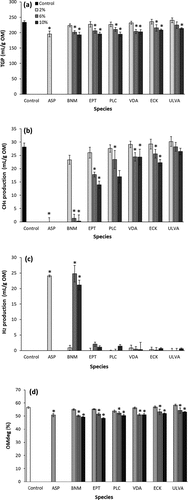Figures & data
Table 1. Collection sites of seaweed specimens used for this study. All locations were within the North Island, New Zealand.
Figure 1. Mean (± SE, n = 3) (a) total gas (TGP), (b) CH4, and (c) H2 production (ml g–1), and (d) degradability of organic matter (OMdeg, % degraded) at the end of in vitro incubations for freeze-dried perennial ryegrass (RG299, negative control), and seaweed species Asparagopsis armata (ASP, positive control), Bonnemaisonia hamifera (BNM), Euptilota formisissima (EPT), Plocamium cirrhosum (PLC), Vidalia colensoi (VDA), Ecklonia radiata (ECK), and Ulva sp. B (ULVA) at inclusion levels of 2%, 6%, and 10% (OM-based) (24 h data).*Indicates treatment significantly different (p < 0.05) from control according to PERMANOVA.

Table 2. Elemental composition (wt%) of carbon (C), hydrogen (H), nitrogen (N), sulphur (S), bromine (Br), chlorine (Cl), and iodine (I), and concentration (mg/g DW) of bromoform (BF) for seaweed species Asparagopsis armata (ASP, positive control), Bonnemaisonia hamifera (BNM), Euptilota formisissima (EPT), Plocamium cirrhosum (PLC), Vidalia colensoi (VDA), Ecklonia radiata (ECK), and Ulva sp. B (ULVA).
Table 3. Composition (%DW) of organic matter (OM), ash, crude protein (CP), crude fat (CF), acid detergent fibre (ADF), neutral detergent fibre (NDF), soluble sugars, starch, and polyphenols (PP) (mg/g DW) for perennial ryegrass (negative control), and seaweed species Asparagopsis armata (ASP, positive control), Bonnemaisonia hamifera (BNM), Euptilota formisissima (EPT), Plocamium cirrhosum (PLC), Vidalia colensoi (VDA), Ecklonia radiata (ECK), and Ulva sp. B (ULVA).
Table 4. Effect of seaweed species Asparagopsis armata (ASP, positive control), Bonnemaisonia hamifera (BNM), Euptilota formisissima (EPT), Plocamium cirrhosum (PLC), Vidalia colensoi (VDA), Ecklonia radiata (ECK), and Ulva sp. B (ULVA) (mean ± SE, n = 3) at inclusion levels of 0% (perennial ryegrass, negative control), 2%, 6%, and 10% (OM-based) on total (mmolg–1) and individual volatile fatty acid (VFA) (% total) production at the end of in vitro incubations (48 h data).
